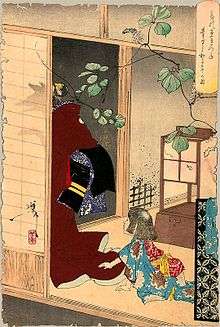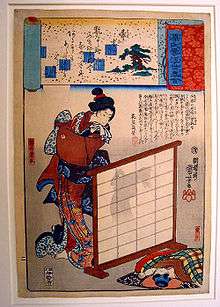Kuzunoha
Kuzunoha (葛の葉, Kuzunoha), also written Kuzu-no-Ha, is the name of a popular kitsune character in Japanese folklore. Her name means kudzu leaf. Legend states that she is the mother of Abe no Seimei, the famous onmyōji.
Legend

The young nobleman Abe no Yasuna (安倍 保名), on his way to visit a shrine in Shinoda, in Settsu Province, encounters a young military commissioner who is hunting foxes in order to obtain their livers for use as medicine. Yasuna battles the hunter, sustaining several wounds in the process, and sets free the white fox he had trapped. Afterward, a beautiful woman named Kuzunoha comes along and helps him return to his home.
In reality, this woman is the fox he had saved, adopting human form in order to tend to his wounds. He falls in love with her, and they marry. Later, she bears him a child, Seimei (childhood name Dōji), who proves prodigiously clever. Kuzunoha realizes that her son has inherited part of her supernatural nature.
Several years later, while Kuzunoha is viewing some chrysanthemums, her son catches sight of the tip of her tail. Her true nature revealed, Kuzunoha prepares to depart to return to her life in the wild. She leaves behind a farewell poem, asking her husband Yasuna to come to see her in Shinoda forest.
Yasuna and his son search Shinoda for Kuzunoha, and eventually she appears to them as a fox. Revealing that she is the kami, or deific spirit, of Shinoda shrine, she gives her son Seimei a gift, allowing him to comprehend the language of beasts.[1]
Plays
Kuzunoha figures in kabuki and bunraku plays based on her legend, including the five-part Ashiya Dōman Ōuchi Kagami (A Courtly Mirror of Ashiya Dōman). The fourth part, Kuzunoha or The White Fox of Shinoda, which is frequently performed independently of the other scenes, focuses on her story, adding minor variations such as the idea that Kuzunoha imitates a princess and is forced to depart not because Seimei glimpsed her tail but because the real woman unexpectedly appears.[1][2]
In Izumi
In Izumi there is a Kuzunoha Inari shrine, said to be built upon the place at which Kuzunoha departed, leaving her farewell poem on a silk screen.[3]
The poem itself has become famous: "Koishiku ba / tazunekite miyo / izumi naru / shinoda no mori no / urami kuzunoha." Folklorist Kiyoshi Nozaki offers the following translation: "If you love me, darling, come and see me. / You will find me yonder in the great wood / Of Shinoda of Izumi Province where the leaves / Of arrowroots always rustle in pensive mood." [1]
A pond in the area is also remembered in connection with the legend, and has been designated a historic site by the city.[3]
References
- Nozaki, Kiyoshi. Kitsune — Japan's Fox of Mystery, Romance, and Humor. Tokyo: The Hokuseidô Press. 1961. 110-111
- "Ashiya Dōman Ōuchi Kagami" (php). Kabuki21.com. Retrieved 2006-12-12.
- Izumi website Book of Izumi City. "Protecting and Cherishing the Ancient Historical and Cultural Traditions of the Area." "Archived copy". Archived from the original on 2008-05-03. Retrieved 2014-08-08.CS1 maint: archived copy as title (link)
- Goff, Janet E. Conjuring Kuzunoha from the World of Abe no Seimei. A Kabuki Reader: History and Performance, ed. Samuel L. Leiter. New York: M. E. Sharpe, 2001. (ISBN 0-7656-0704-2)
- Mailahn, Klaus: Der Fuchs in Glaube und Mythos, Münster 2006, 170-172, 179-184, ISBN 3-8258-9483-5
External links
| Wikimedia Commons has media related to Kuzunoha. |
- Netsuke: masterpieces from the Metropolitan Museum of Art, an exhibition catalog from The Metropolitan Museum of Art (fully available online as PDF), which contains many representations of Kuzunoha

